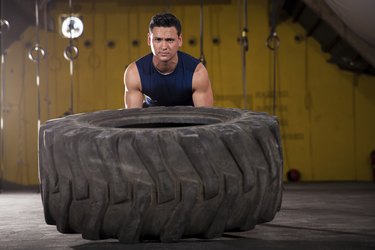
Both height and individual proportions affect how much you can lift. A taller lifter may be better at certain lifts while a shorter lifter may be better at other lifts. The width of your frame will also have an effect on your ability to perform certain lifts. Consult your physician before beginning any diet or exercise program.
The Squat
Video of the Day
The squat is a basic leg strengthening exercise that involves bending down with a barbell held securely on your upper back. Shorter lifters will generally have an advantage when performing the squat as they do not have as far to go to break parallel and stand back up. An individual with very short legs and a long torso has a distinct advantage in this lift as he not only has less range to squat through, but is able to maintain a more upright posture when squatting. This allows him to take more advantage of the power of his legs while keeping the bar solidly in line with the heels, and reduces the rotation at the knee joint.
Video of the Day
The Bench Press
Height does not have as much to do with this lift as the length of your arms does. A lifter who is proportional with roughly the same sleeve length as her inseam length has no advantage or disadvantage. If your arms are so long you scrape your knuckles on the stairs as you climb them, you are going to have problems benching because you need to shove the bar a very long way, doing more work than someone with very short arms. One of the best powerlifters of all-time in the 114 lbs. class is Andrzej Stanaszek, who holds the world records in his class in the squat and bench press. Stanaszek has been diagnosed with dwarfism.
The Deadlift
This is a lift where the taller lifter tends to do better, as taller athletes usually have longer arms. Pulling the bar off the ground is easier when you do not have to pull it as far. Proportionally, a lifter with a shorter torso and longer arms will do even better, as he does not have to bend over as far and keeps the bar closer to his body, reducing the shearing force on the lower back. If you have a long torso and short arms, you are going to struggle with the deadlift.
Width
The width of your body also has an effect on how much you can lift, although not as much. A wider hip structure makes you more stable in the squat and the muscles of your back and core do not have to work as hard to stabilize the weight as if you were skinny. Conversely, if you have narrow hips you can keep your hands closer together when deadlifting, which reduces the angle your torso has to start with relative to the floor, making the initial pull easier.
- "Medicine & Science in Sports & Exercise"; Biomechanics of the Knee During Closed Kinetic Chain and Open Kinetic Chain Exercises; Rafael F. Escamilla et al.; April 1998
- "Journal of Physical Anthropology:" Muscle Power Output Properties Using the Stretch-shortening Cycle of the Upper Limb and Their Relationships with a One-Repetition Maximum Bench Press; 2006
- Powerlifting World Records
- "Medicine and Science in Sports and Exercise"; A Three-dimensional Biomechanical Analysis of Sumo and Conventional Style Deadlifts; Rafael F. Escamilla et al., Jul 2000